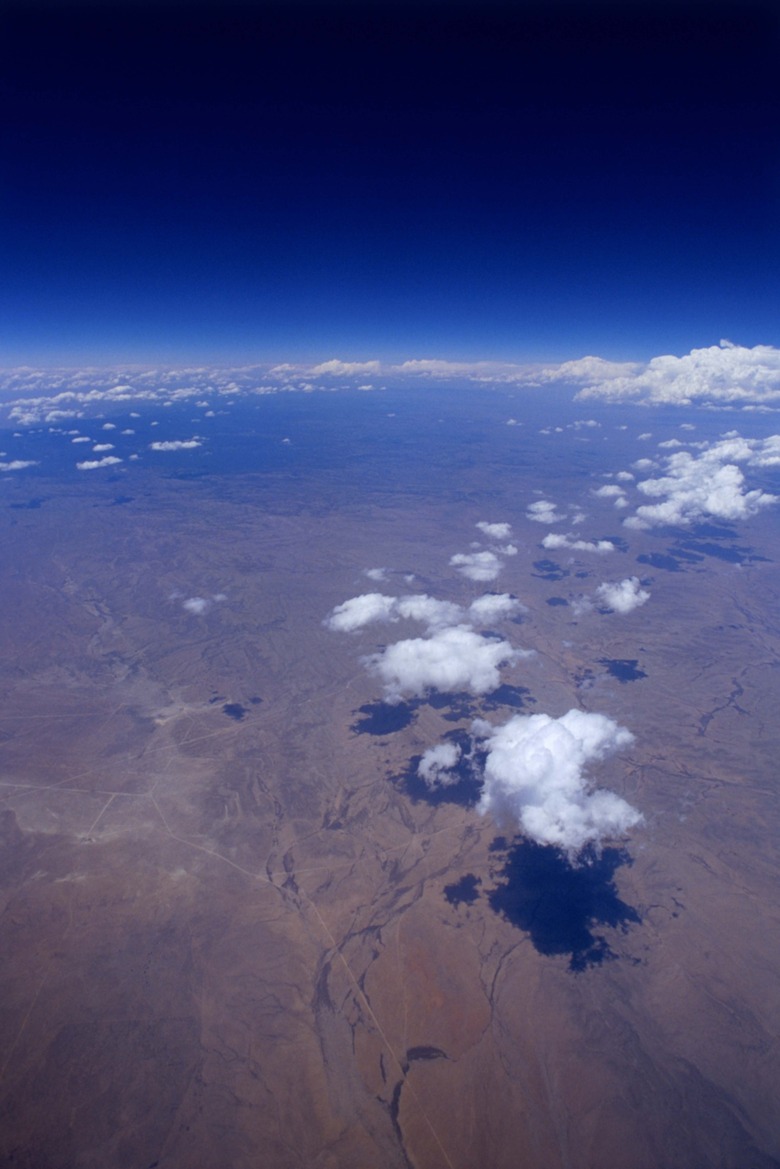Cross Section Of The Earth's Atmosphere
Earth's atmosphere plays a critical role in human life that goes beyond providing oxygen to breathe. This thin but vital blanket also protects life on Earth from meteorite bombardment and deadly radiation. By taking a cross-section of the atmosphere, you can divide it into a number of layers, each with its distinctive temperatures and functions.
Troposphere
Troposphere
All of Earth's weather takes place in the atmosphere's lowest layer, the troposphere. This is where large air currents generated by temperature differences in the atmosphere carry heat and create the familiar weather patterns we all experience.
Although the troposphere is only about 11 miles thick, it's much more dense than the atmosphere's outer layers. That's why it contains some 80 percent of the total air in the atmosphere. As you climb higher in the troposphere, the air gets colder and drier, and the air pressure drops rapidly. The top of the troposphere exerts only 10 percent of air pressure at sea level.
Stratosphere
Stratosphere
Above the troposphere lies the stratosphere, which extends from about 11 to 30 miles above the Earth. Most air currents in this layer are horizontal and run parallel to the planet's surface.
High in the stratosphere lies a region called the ozone layer, where ozone gas (O3 molecules) absorbs harmful ultraviolet (UV) light from the sun. Temperatures at the base of the stratosphere average -110 degrees Fahrenheit, but climbing higher toward space, the air actually gets warmer. Ozone absorbs UV and releases heat. That's why the temperature near the top of the stratosphere increases to the freezing point, 32 degrees Fahrenheit.
Mesosphere & Ionosphere
Mesosphere & Ionosphere
The next layer in the atmosphere's cross-section is the mesosphere, located roughly from 30 to 52 miles up. Here again, the temperature falls with increasing altitude. Although the air here is very thin, it's thick enough that most meteors burn up in this layer and never make it to Earth's surface.
Located about 52 miles above Earth's surface, the mesosphere becomes the ionosphere, a layer composed primarily of ions, particles that have lost or gained electrons. Auroras, the dazzling electrical displays of northern and southern skies, occur here.
Exospere & Outer Space
Exospere & Outer Space
There's no precisely defined point where Earth's atmosphere ends and outer space begins. The ionosphere is sometimes considered part of space. In fact, many satellites travel within this layer.
At 430 miles or so above Earth's surface, the ionosphere gives way to the outermost layer of Earth's atmosphere, the exosphere. The depth of this layer expands when the sun is quiet and contracts when Earth's atmosphere is battered by solar storms.
As you travel farther and farther outward into space, the air density continues to decrease. At 600 to 1,000 miles in altitude, you are well and truly in outer space.
Cite This Article
MLA
Brennan, John. "Cross Section Of The Earth's Atmosphere" sciencing.com, https://www.sciencing.com/cross-section-earths-atmosphere-2061/. 24 April 2017.
APA
Brennan, John. (2017, April 24). Cross Section Of The Earth's Atmosphere. sciencing.com. Retrieved from https://www.sciencing.com/cross-section-earths-atmosphere-2061/
Chicago
Brennan, John. Cross Section Of The Earth's Atmosphere last modified March 24, 2022. https://www.sciencing.com/cross-section-earths-atmosphere-2061/
